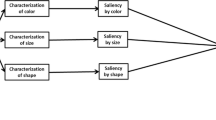Abstract
Based on salient visual regions for mobile robot navigation in unknown environments, a new place recognition system was presented. The system uses monocular camera to acquire omni-directional images of the environment where the robot locates. Salient local regions are detected from these images using center-surround difference method, which computes opponencies of color and texture among multi-scale image spaces. And then they are organized using hidden Markov model (HMM) to form the vertex of topological map. So localization, that is place recognition in our system, can be converted to evaluation of HMM. Experimental results show that the saliency detection is immune to the changes of scale, 2D rotation and viewpoint etc. The created topological map has smaller size and a higher ratio of recognition is obtained.
Similar content being viewed by others
References
Guilherme N D, Avinash C K. Vision for mobile robot navigation: a survey[J]. IEEE Transaction on Pattern Analysis and Machine Intelligence, 2002, 24(2): 1–31.
Lowe D. Object recognition from local scale invariant features[C]// IEEE International Conference on Computer Vision. Corfu: IEEE Computer Society, 1999: 1150–1157.
Sim R, Dudek G. Learning visual landmarks for pose estimation[C]// IEEE International Conference on Robotics and Automation. Detroit, 1999: 1972–1978.
Ulrich I, Nourbakhsh I. Appearance based place recognition for topological localization[C]// IEEE International Conference on Robotics and Automation. San Francisco, 2000: 1023–1029.
Zhou C, Wei Y C, Tan T N. Mobile robot self-localization based on global visual appearance features[C]// IEEE International Conference on Robotics and Automation. Taipei, 2003: 1271–1276.
Artac M, Jogan M, Leonardis A. Mobile robot localization using an incremental eigenspace model [C]// IEEE International Conference on Robotics and Automation. Washington, 2002: 1025–1030.
Duda R, Hart P, Stork D. Pattern classification[M]. 2nd ed. Beijing: China Machine Press, 2004.
Andrade-Cetto J, Sanfeliu A. Topological map learning for a mobile robot in indoor environments [C]// Sanchez J, Pla F. 9th Spanish Sympsium on Pattern Recognition and Image Analysis. Barcelona, 2001: 221–226.
Vale A, Ribeiro M I. A probabilistic approach for the localization of mobile robots in topological maps[C]// 10th IEEE Mediterranean Conference on Control and Automation. Lisbon, 2002: 693–702.
Lindeberg T. Scale-space theory: a basic tool for analysing structures at different scales[J]. Journal of Applied Statistics, 1994, 21(2): 225–270.
Heisenberg M, Wolf R. Studies of brain function [M]. Berlin: Springer- Verlag, 1984.
Eduardo T, Torras C. Detection of nature landmarks through multi — scale opponent features[C]// IEEE International Conference on Pattern Recognition. Barcelona. 2000: 3988–3991.
SHENG Wen, XIA Bin. Texture segmentation method based on Gabor ring filtering[J]. Infrared and Laser Engineering, 2003, 32(5): 484–488. (in Chinese)
Mikolajczyk K, Schmid C. Scale & affine invariant interest point detectors[J]. International Journal of Computer Vision, 2004, 60(1): 63–86.
Rybski J, Zacharias F, Papanikopoulous N. Using visual features to build topological maps of indoor environments[C]// IEEE International Conference on Intelligent Robots and Systems. Las Vegas, 2003: 194–199.
Harris C, Stephens M. A combined corner and edge detector[C]// Taylor C J. Alvey Vision Conference. Manchester: University of Manchester Press, 1988: 147–151.
Author information
Authors and Affiliations
Corresponding author
Additional information
Foundation item: Projects(60234030, 60404021) supported by the National Natural Science Foundation of China
Rights and permissions
About this article
Cite this article
Wang, L., Cai, Zx. Place recognition based on saliency for topological localization. J Cent. South Univ. Technol. 13, 536–541 (2006). https://doi.org/10.1007/s11771-006-0083-8
Received:
Accepted:
Published:
Issue Date:
DOI: https://doi.org/10.1007/s11771-006-0083-8




